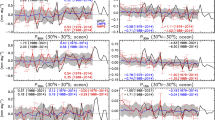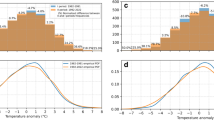Abstract
Based on the EAP (East Asia/Pacific) teleconnection in the summer circulation anomalies over the Northern Hemisphere, an index measuring the strength of the East Asian summer monsoon, i.e., the socalled EAP index, is defined in this paper. From the analyses of observed data, it is clearly shown that the EAP index defined in this study can well describe the interannual variability of summer rainfall and surface air temperature in East Asia, especially in the Yangtze River valley and the Huaihe River valley, Korea, and Japan. Moreover, this index can also reflect the interannual variability of the East Asian summer monsoon system including the monsoon horizontal circulation and the vertical-meridional circulation cell over East Asia. From the composite analyses of climate and monsoon circulation anomalies for high EAP index and for low EAP index, respectively, it is well demonstrated that the EAP index proposed in this study can well measure the strength of the East Asian summer monsoon.
Similar content being viewed by others
References
Ding, Y. H., 1994: Monsoon over China. Kluwer Academic Publishers, 420pp.
Guo Qiyun, 1983: The strength index of East Asian summer monsoon and its variation.Chinese J. Geography. Soc.,38, 207–217. (in Chinese)
Huang Ronghui, and Li Weijing, 1987: Influence of heat source anomaly over the tropical western Pacific on the subtropical high over East Asia. Proc. International Conference on the General Circulation of East Asia, Chengdu, China, April 10–15, 1987, 40–45.
Huang Ronghui, and Li Weijing, 1988: Influence of heat source anomaly over the western tropical Pacific on the subtropical high over East Asia during summer and its physical mechanism.Chinese J. Atmos. Sci., Special Issue, 107–117. (in Chinese)
Huang Ronghui, and Sun Fengying, 1992: Impact of the tropical western Pacific on the East Asian summer monsoon.J. Meteor. Soc. Japan,70(1B), 243–256.
Huang Ronghui, Xu Yuhong, Wang Pengfei, and Zhou Liantong, 1998: The features of the catasfrophic flood over the Changjiang River basin during the summer of 1988 and cause exploration.Climatic Environ. Res.,3, 300–313. (in Chinese)
Huang Ronghui, Zhang Zhenzhou, and Huang Gang, 1998: characteristics of water vapor transport in East Asian monsoon region and its differences from that of South Asian monsoon region in summer.Chinese J. Atmos. Sci.,22, Special Issue, 368–379. (in Chinese)
Huang Ronghui, and Zhou Liantong, 2002: Research on the characteristics, formation mechanism and prediction of severe climate disasters in China.J. Natural Disasters,11, 1–9. (in Chinese)
Kurihara, K., 1989: A climatological study on the relationship between the Japanese summer weather and the subtropical high in the western northern Pacific.Geophys. Mag.,43, 45–104.
Murakami, T., and J. Matsumoto, 1994: Summer monsoon over the Asian continent and western North Pacific.J. Meteor. Soc. Japan,72, 745–791.
Nitta, Ts., 1987: Convective activities in the tropical western Pacific and their impact on the Northern Hemisphere summer circulation.J. Meteor. Soc. Japan,64, 373–390.
Nitta, Ts., and Z. Z. Hu, 1996: Summer climate variability in China and its association with 500 hPa height and tropical convections.J. Meteor. Soc. Japan,74, 425–445.
Ramage, C., 1971:Monsoon Meteorology, International Geophysics Series, 15, Academic Press, San Diego, California., 296pp.
Shi Neng, Zhu Qiangen, and Wu Bingui, 1996: The East Asian summer monsoon in relation to summer largescale weather-climate anomaly in China for last 40 years.Chinese J. Atmos. Sci.,20, 385–394. (in Chinese)
Tao Shiyan, and Chen Longxun, 1985: The East Asian summer monsoon. Proc. of International Conference on Monsoon in the Far East, Tokyo. Nov. 5–8. 1985, 1–11.
Tao Shiyan, and Chen Longxun, 1987: A review of recent research on the East Asian summer monsoon in China.Monsoon Meteorology, C. P. Chang and T. N. Krishnamurti, Eds., Oxford University. Press, 60–92.
Webster, P. J., and S. Yang, 1992: Monsoon and ENSO: Selectively interactive system.Quart. J. Roy. Meteor. Soc,118, 877–926.
Ye Duzheng, and Huang Ronghui, 1996:Research on the Regularity and Cause of Droughts and Floods in the Yellow River and the Yangtze River Valleys, Shandong Press for Science and Technology, 384pp. (in Chinese)
Zeng Qingcun, Zhang Banglin, and Liang Youlin, 1994: East Asian summer monsoon-A case study.Proceedings of the Indian National Science Academy. Indian Nat. Sci. Acad.,60, 81–96.
Zhang Qingyun, and Peng Jingbei, 2003: Influence of the interannual and interdecadal variations of atmospheric circulation over East Asia on the landing typhoon in China.Chinese J. Atmos. Sci.,27, 97–106. (in Chinese)
Author information
Authors and Affiliations
Corresponding author
Rights and permissions
About this article
Cite this article
Huang, G. An index measuring the interannual variation of the East Asian summer monsoon—The EAP index. Adv. Atmos. Sci. 21, 41–52 (2004). https://doi.org/10.1007/BF02915679
Received:
Revised:
Published:
Issue Date:
DOI: https://doi.org/10.1007/BF02915679




